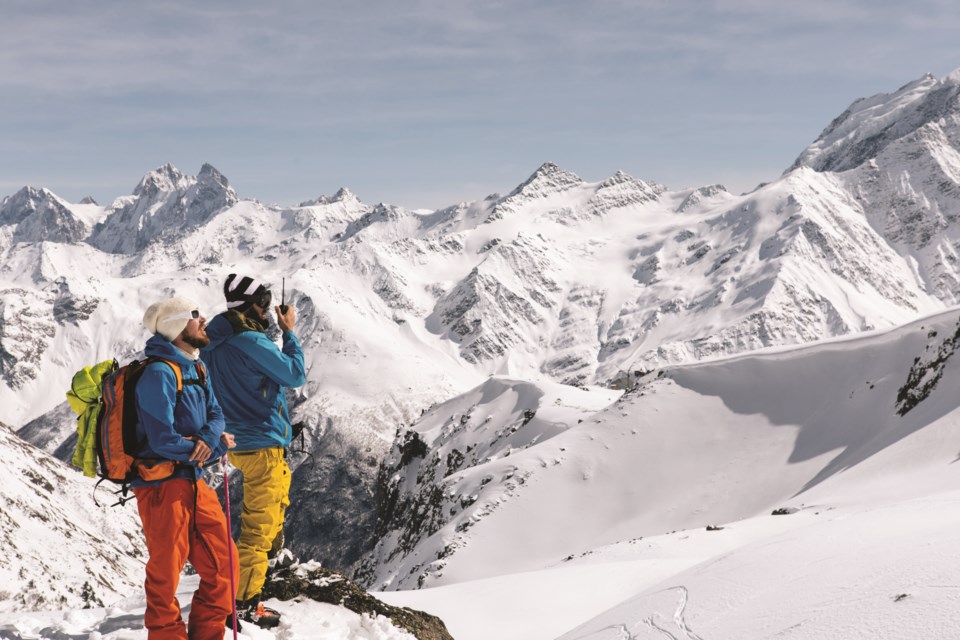If there’s one thing Whistlerites love complaining about more than terrible weather, it’s traffic. People are sick of hearing about how long it took to get from the Callaghan to the Day Lots, especially when people voice that very complaint from idling vehicles in the crawling procession itself. Vis-à-vis, you ARE traffic. But there’s another congestion building up around town. Not of lift lines or vehicles queuing up at the Husky, but in the form of radio waves.
I’ll preface the remainder of this column by saying that radio communication is an extremely technical subject with rabbit holes at every step. So I’ll do my best to keep the information digestible and may loop back on this subject later in the season.
Two-way radio communication has been a cornerstone of emergency response for decades. It’s also a critical tool for any logistics operation, whether you’re hauling logs down an FSR or driving tourists around for their zipline experience. Historically, handheld two-way radios were expensive pieces of electronics used by commercial and government operations and the odd amateur hobbyist. Regular folks would use Family Radio Service (FRS)—also called General Mobile Radio Service (GMRS)—which is basically an improved walkie-talkie system for short-range, line-of-sight communication. The handheld devices were reasonably cheap (almost toy-like) and you could buy them pretty much anywhere, but they were also quite underpowered and not so reliable once you start to get into longer distances or complex, mountainous terrain. The limited bandwidth for the channels also meant you’d have to share your communication with several other families jabbering on the ski hill.
Some years ago, non-professional backcountry users realized that they would be safer if they had the same reliable two-way communication that the professionals were using within their group and perhaps with other groups in the area. There were likely others before it, but the BCA Link Group Communication System was the first I remember seeing that packaged a device specifically for winter backcountry groups; it was durable, had a rechargeable battery with a decent life, and it could be dropped in the snow and would still work. It also had a larger range of FRS frequencies and privacy channels so you could isolate your conversation from other parties. The BCA Link system (the new 2.0 version which retails for about $229 plus tax per device) is now considered the industry standard for recreational radio communication, but plenty of other companies such as Rocky Talkie, Roam and Mountain Lab make their own version with the same compatible channels as BCA Link.
The lower-cost option to the above brands you’ve probably heard of is the Baofeng UV-5R. From what the YouTube experts say, there are dozens of versions of this radio, but for most purposes, the UV-5R is sufficient. This device has a bit more of a power-user interface but can be programmed to the same BCA Link channels and even to B.C. resource road (RR) channels. The durability and reliability of Baofengs are of course diminished when you pay half to a third of what you would for the aforementioned outdoor brand radios. Yes, they work OK, but there are also plenty of well-documented shortfalls that I won’t list here (but Google it if you want to know more).
Two-way radios are quickly becoming a standard piece of gear for backcountry safety, especially amongst snowmobilers. The vast distances sledders can cover means getting help from your mates (who are likely not in the line of sight) requires a two-way radio. Experienced sledders will attest that two-way radios save lives.
Now back to the traffic complaint. FRS radios do not require a licence, and with no real etiquette or guidelines in place, channels are beginning to get crowded. Finding a quiet channel at busy ski touring and snowmobile trailheads on the weekend can be challenging. Further to the annoyance of strangers squawking in your pocket all day, the interference could impede a self-rescue emergency. I should note here that commercial operators, resource industry, and emergency services are all on Land Mobile Radio (LMR) frequencies, which require licence fees and higher-powered devices, and can utilize repeater towers. So FRS group chatter won’t interfere with that. But imagine trying to communicate about a looming overhead hazard to your partner a few hundred metres up the slope and the channel gets constantly interrupted by another seven-member group engaging in aimless chatter about how sick their line was.
Revelstoke-based backcountry skier and amateur radio enthusiast John Bell posed a few potential solutions to this issue in one of his recent online presentations titled “The State of Backcountry Radio Communications.” He proffered that a sort of community agreement is needed where users stick to succinct communications and don’t dominate channels. Bell has even encouraged a kind of daily check-in in the Rogers Pass area, where at a certain time of day (say 12 noon), parties check in on a common frequency and exchange avalanche and snowpack observations. I don’t see that as a realistic option for a Saturday in Brandywine, but our own backcountry user groups are surely capable of implementing a community agreement that works for everyone involved.
To learn more about backcountry radio communication, head to facebook.com/groups/RevelstokeAmateurRadioCourses.
Vince Shuley is in the market for a two-way radio. For questions, comments or suggestions for The Outsider email [email protected] or Instagram @whis_vince.




